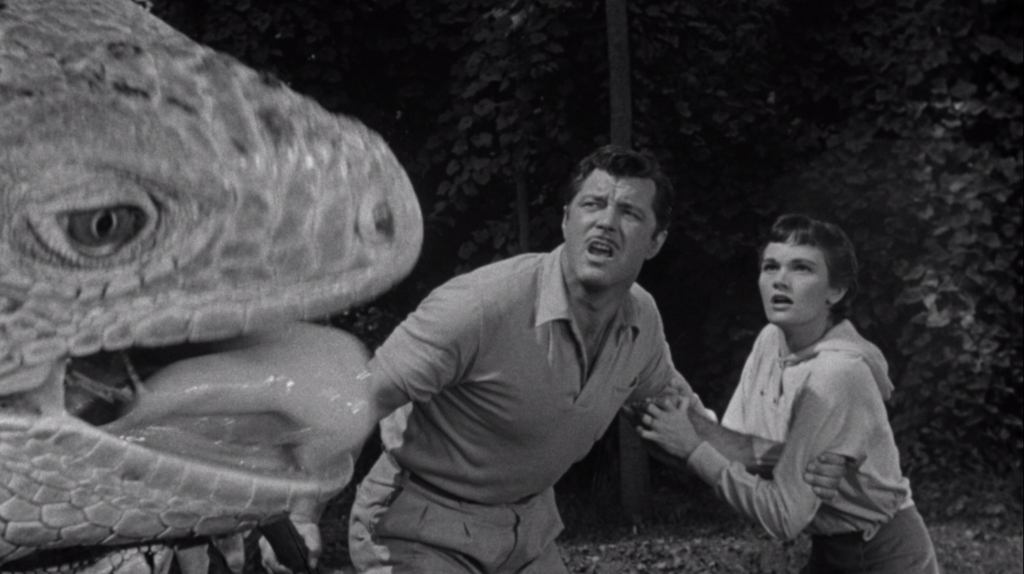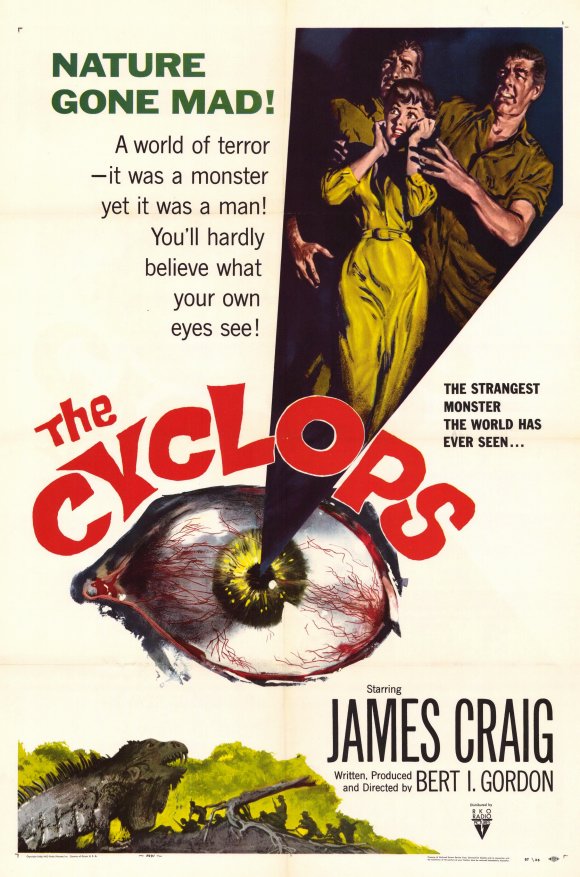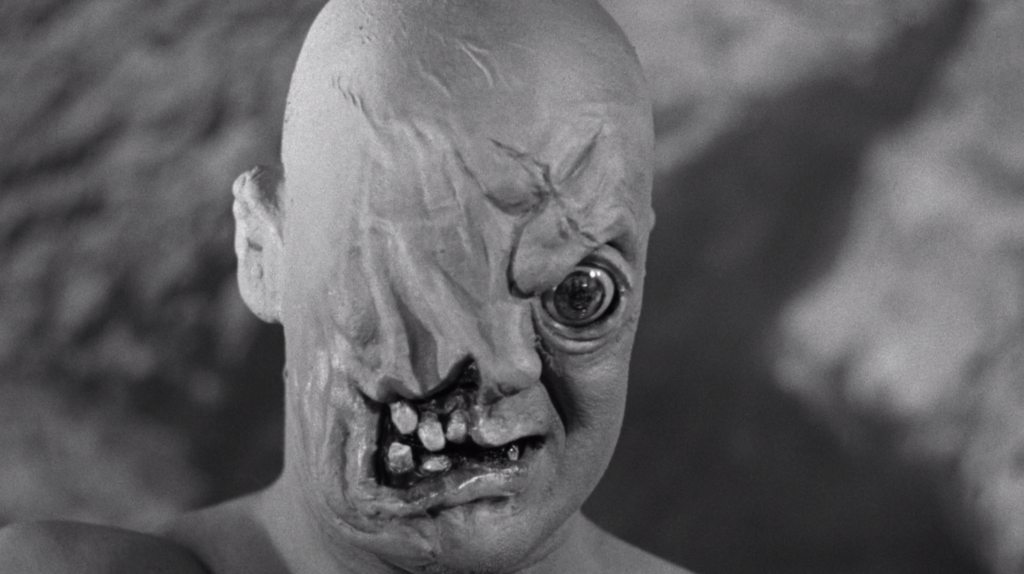
Following the endearing dinosaur planet movie King Dinosaur (1955), in which the titular dinosaur was an overgrown iguana, Wisconsin’s own Bert I. Gordon embarked upon The Cyclops (1957), writing, producing, directing, and contributing special effects. He completed production in 1956 with a journeyman cast and the giant creatures that would earn him the shorthand “Mr. B.I.G.” Running just over an hour, The Cyclops features a threadbare plot, advances rather quickly to its monsters, and soon enough moves in on its central beast before hurrying through a climax. If fast food were a 50’s B-movie, that would be The Cyclops. Opening, as a title card tells us, in fictional Guayjorm, Mexico, we are introduced to Susan Winters (Gloria Talbott, a busy actress who had recently appeared in Douglas Sirk’s All That Heaven Allows), who has come to Mexico to find her fiancé Bruce Barton. Barton’s plane crashed three years ago somewhere in the mountains of the Sierra Tarahumare, and no one but Susan believes that he’s still alive. She’s arrived in town with three others, helpfully described by Guayjorm’s governor (Vicente Padula) in expositional dialogue before Susan has entered the room: pilot Lee Brand (Tom Drake, Meet Me in St. Louis), bacteriologist Russ Bradford (top-billed James Craig, recently seen in Fritz Lang’s While the City Sleeps), and Martin Melville (Lon Chaney, Jr., far from The Wolf Man), who helped finance the expedition on the hope that he’ll discover uranium deposits and make a fortune. The governor denies Susan’s request to fly into the restricted area where Barton’s plane went down, and tells her, as everyone does in the film every couple of minutes, that Barton is surely dead. This is the kind of movie where the governor explains that Martin has brought a “precision scintillator” for detecting uranium, and that it could even work from a plane in flight. A couple scenes later, Martin is using his scintillator on a plane. We have been well prepared.
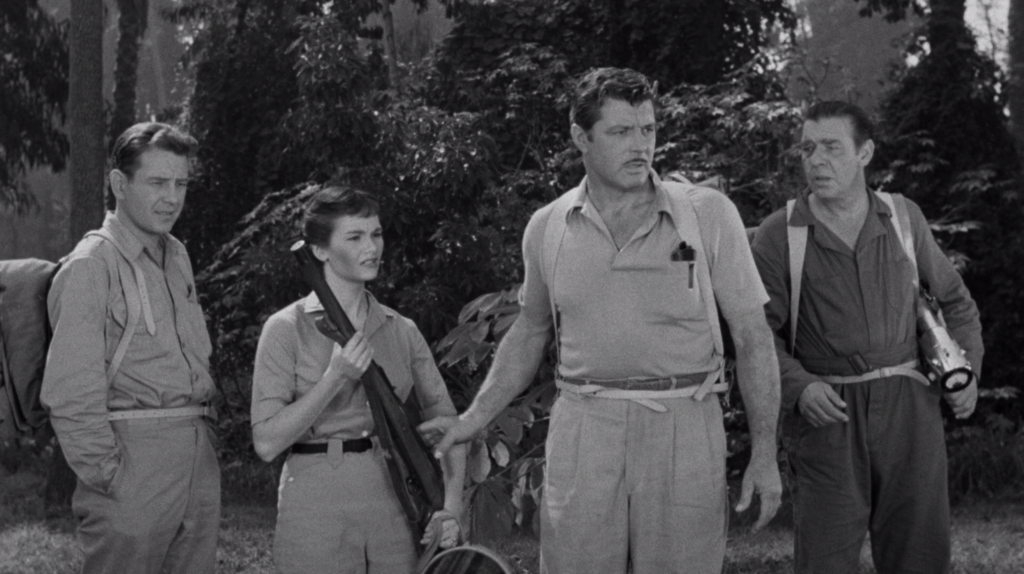
Explorers Tom Drake, Gloria Talbott, James Craig, and Lon Chaney encounter colossal-sized trouble.
The four steal their transportation after Chaney limply socks their soldier pilot in an airfield, then fly into the restricted area. After nearly crashing thanks to the uranium-hungry Martin wrestling for controls, they set down and promptly encounter a giant lizard. The next day, Susan and Lee watch as a giant mouse is assaulted by a giant hawk. Lee says, “Now I know I wasn’t imagining things when I saw that giant lizard yesterday!” After the hawk has mauled the mouse, Susan poses the thoughtful question, “Why are they so large?” “I don’t know,” says Lee, “but I intend to find out.” Martin can’t locate any uranium deposits, but he gets radioactive readings from everywhere. Russ theorizes the gigantism might be caused by the radiation. Next up, to further his theory, are a giant tarantula, a giant gila monster, and a giant iguana, some of them semi-transparent, a fact that’s more distracting than the frequent mismatched eyelines. The iguana has a lion’s roar because it’s big, and this is what big things sound like. Susan and Lee take shelter in the river, which offers a surprising cheesecake wet tee-shirt moment from Talbott. After a gila monster/iguana battle, standard stuff in the vein of the Victor Mature vehicle One Million B.C. (1940), the cyclops makes his first appearance through a cyclops eye-POV shot of Susan screaming. “It came for me!” she tells her companions afterward. “The eye!”
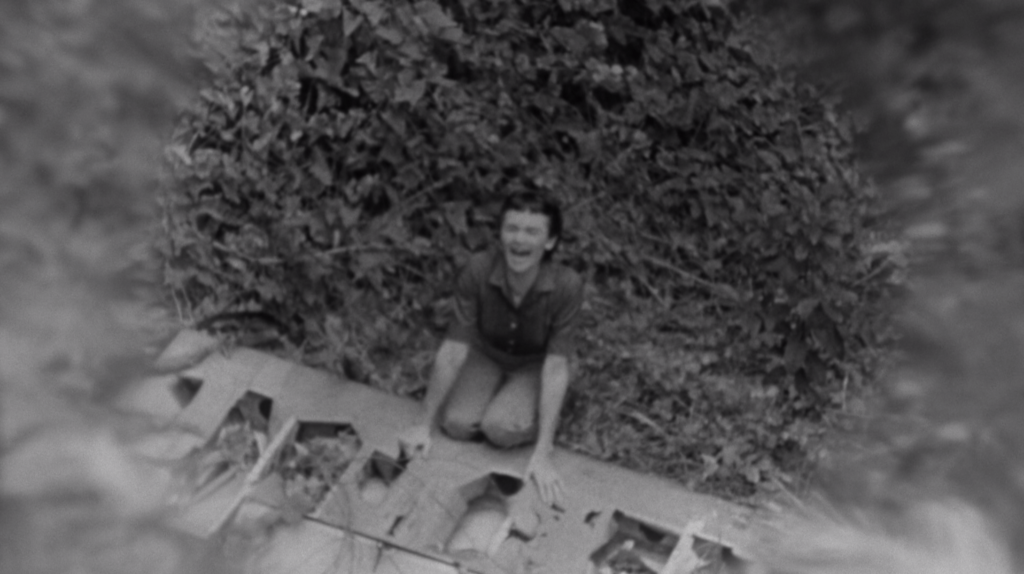
Bert I. Gordon’s unique bit of Cyclops-vision.
In a clever turn of events, the giant cyclops soon traps the explorers inside a cave with a boulder, recreating the mythological confrontation between Odysseus and Polyphemus – an episode which had been recently depicted in the 1954 Italian production Ulysses with Kirk Douglas and Anthony Quinn. His sudden reveal, popping up from behind the boulder, is both a progenitor of the jump scare – it’s queued to make an audience of Baby Boomer kids scream – and utterly hilarious, in part because of the over-the-top grotesquerie of the makeup. Part of that makeup is a telltale scar which seems to link the cyclops to Susan’s missing fiancé. Having spent the entire film telling Susan to accept the obvious, that Bruce Barton is dead, her companions now tell her she must accept the obvious, that Bruce Barton has mutated into a 25-foot-tall cyclops. At one point Susan tells Russ that it sounds like he’s enjoying all this, and he responds, “I am – as a scientist!” Inside the cave, Martin begins to panic, offering Lon Chaney his most authentically delivered line in the film: “I need a drink.” He steals a rifle during the night, and later uses it to shoot the beast, which reacts by gently knocking him to the floor, thus removing him entirely from the rest of the story. The three survivors find their opportunity to escape when the one-eyed Barton inexplicably becomes locked in a life-or-death battle with a giant python, which he carefully drapes over his shoulders. Finally, they subdue the cyclops in the manner of Odysseus/Ulysses/Kirk Douglas, plunging a stick into its eye. In the uncensored version of the film, this is graphically depicted, while the monster is reduced to mewling noises. Such a key shock moment, it’s even symbolized with a graphic on the marketing material, with the poster image of the actors inside a kind of spike stuck straight into a bloodshot eye. (As a more honest warning, a smaller image of an iguana is also included.) Credit Gordon for one thing – he beat Ray Harryhausen to the punch, albeit with less impressive special effects. A year later, Harryhausen would release a much more groundbreaking cyclops film with a Homeric influence: The 7th Voyage of Sinbad. As for Gordon, he’d move on to the only natural follow-up to The Cyclops: The Amazing Colossal Man (1957).
